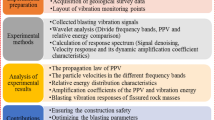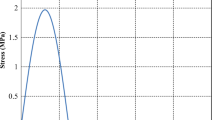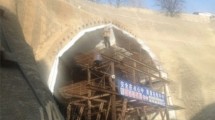Abstract
Ground vibrations are an integral part of the process of rock blasting. The analysis of blasting vibration attenuation is the basis for a blasting risk assessment. To study the influence of rock joints on the blasting vibration attenuation, an autoclaved aerated concrete block was used as a similar material of rock in model tests of blasting vibration propagation. The attenuation process of the blasting vibration was physically simulated. The attenuation behaviors of the blasting vibrations in different directions to joint strike were fitted. Additionally, a positive correlation between the attenuation parameters and the directions was obtained. Furthermore, the Hilbert–Huang transform (HHT) based on the complete ensemble empirical mode decomposition with adaptive noise (CEEMDAN) was used to analyze the vibration velocity signals. The characteristics and variation of the energy distribution were studied in the time–frequency domain. The results showed that the energy amplitude decreased as the propagation distance increased. The energy distribution gradually evolved from concentrated to discrete in the frequency domain. The low-frequency components were always present in the velocity signals at each measurement point, but the high-frequency components constantly changed due to the reflection and transmission of the waves after encountering the joint surfaces. The results of this study provide a reference for the prediction and control of the blasting vibration effect in jointed rock masses.


















Similar content being viewed by others
References
Ambraseys NN, Hendron AJ (1968) Dynamic behaviour of rock masses. In: Stagg KG, Zienkiewicz OC (eds) Rock mechanics in engineering practices. Wiley, London, pp 203–207
Ayenu-Prah A, Attoh-Okine N (2010) A criterion for selecting relevant intrinsic mode functions in empirical mode decomposition. Adv Adapt Data Anal 2:1–24. https://doi.org/10.1142/S1793536910000367
Bureau of Indian Standards (BIS) (1973) Criteria for safety and design of structures subject to underground blast IS-6922. New Delhi
Chaparro LF, Akan A (2019) Chapter 5 - frequency analysis: the Fourier transform. In: Chaparro LF, Akan A (eds) Signals and systems using MATLAB, 3rd edn. Academic Press, New York, pp 305–362. https://doi.org/10.1016/B978-0-12-814204-2.00015-6
Chen M, Liu T, Ye ZW, Lu WB, Yan P (2019a) Calculation method for the peak pressure on borehole wall for contour blasting. Explosion Stress 39:103–112 (in Chinese). https://doi.org/10.11883/bzycj-2018-0171
Chen ZS, Rhee SH, Liu GL (2019b) Empirical mode decomposition based on Fourier transform and band-pass filter. Int J Nav Arch Ocean 11:939–951. https://doi.org/10.1016/j.ijnaoe.2019.04.004
Cheng JY, Huang SJ, Hsieh CT (2015) Application of Gabor–Wigner transform to inspect high-impedance fault-generated signals. Int J Elec Power 73:192–199. https://doi.org/10.1016/j.ijepes.2015.05.010
Duvall WI, Fogelson DE (1962) Review of criteria for estimating damage to residences from blasting vibrations. USBM-I, 5968
Ghasemi E, Kalhori H, Bagherpour R (2016) A new hybrid ANFIS–PSO model for prediction of peak particle velocity due to bench blasting. Eng Comput-Germany 32:607–614. https://doi.org/10.1007/s00366-016-0438-1
Hall L, Bodare A (2000) Analyses of the cross-hole method for determining shear wave velocities and damping ratios. Soil Dyn Earthq Eng 20:167–175
Hao H, Wu YK, Ma GW, Zhou YX (2001) Characteristics of surface ground motions induced by blasts in jointed rock mass. Soil Dyn Earthq Eng 21:85–98. https://doi.org/10.1016/S0267-7261(00)00104-4
Huang NE, Wu ZA (2008) Review on Hilbert-Huang transform: method and its applications to geophysical studies. Rev Geothys 46:1–23. https://doi.org/10.1029/2007RG000228
Huang NE et al (1998) The empirical mode decomposition and the Hilbert spectrum for nonlinear and non-stationary time series analysis. Proc R Soc Lond A 454:903–995. https://doi.org/10.1098/rspa.1998.0193
Huang LQ, Hao H, Li XB, Li J (2018) Source identification of microseismic events in underground mines with interferometric imaging and cross wavelet transform. Tunn Undergr Sp Tech 71:318–328. https://doi.org/10.1016/j.tust.2017.08.024
Huang D, Cui S, Li XQ (2019) Wavelet packet analysis of blasting vibration signal of mountain tunnel. Soil Dyn Earthq Eng 117:72–80. https://doi.org/10.1016/j.soildyn.2018.11.025
Jia YL, Gong QW, Li JX, Zhan JS (2017) The power load combined forecasting based on CEEMDAN and QPSO-SVM Electrical. Meas Instrum 54:16–21 (in Chinese)
Jiang N, Zhou CB, Lu SW, Zhang Z (2017) Propagation and prediction of blasting vibration on slope in an open pit during underground mining. Tunn Undergr Sp Tech 70:409–421. https://doi.org/10.1016/j.tust.2017.09.005
Khandelwal M, Saadat M (2015) A dimensional analysis approach to study blast-induced ground vbration. Rock Mech Rock Eng 48:727–735. https://doi.org/10.1007/s00603-014-0604-y
Langefors U, Kihlström B (1963) The modern technique of rock blasting. Wiley, New York
Li JC, Ma GW (2010) Analysis of blast wave interaction with a rock joint. Rock Mech Rock Eng 43:777–787. https://doi.org/10.1007/s00603-009-0062-0
Li JC, Li HB, Jiao YY, Liu YQ, Xia X, Yu C (2014) Analysis for oblique wave propagation across filled joints based on thin-layer interface model. J Appl Geophys 102:39–46. https://doi.org/10.1007/s00603-009-0062-0
Mateo C, Talavera JA (2018) Short-time Fourier transform with the window size fixed in the frequency domain. Digit Signal Process 77:13–21. https://doi.org/10.1016/j.dsp.2017.11.003
Montesinos ME, Muñoz-Cobo JL, Pérez C (2003) Hilbert–Huang analysis of BWR neutron detector signals: application to DR calculation and to corrupted signal analysis. Ann Nucl Energy 30:715–727. https://doi.org/10.1016/S0306-4549(02)00112-3
Pan CC (2014) Experimental study on influence of unconsolidated Interface fractured depth on the blasting dynamic. J Anhui Univ Sci Technol (Nature Science) 34:61–64 (in Chinese)
Peng JG, Zhang G (2012) Analysis of signal characteristics of swirlmeter in oscillatory flow based on Hilbert–Huang transform (HHT). Measurement 45:1765–1781. https://doi.org/10.1016/j.measurement.2012.04.007
Semmlow J (2018) Chapter 4 - signal analysis in the frequency domain—implications and applications. In: Semmlow J (ed) Circuits, signals and systems for bioengineers, 3rd edn. Academic Press, New York, pp 169–206. https://doi.org/10.1016/B978-0-12-809395-5.00004-7
Simangunsong GM, Wahyudi S (2015) Effect of bedding plane on prediction blast-induced ground vibration in open pit coal mines. Int J Rock Mech Min 79:1–8. https://doi.org/10.1016/j.ijrmms.2015.08.004
Song Y (2016) Principle of similarity model test. China Communications Press Co.Ltd, Beijing (in Chinese)
Song KI, Cho GC (2009) Bonding state evaluation of tunnel shotcrete applied onto hard rocks using the impact-echo method. NDT & E Int 42:487–500. https://doi.org/10.1016/j.ndteint.2009.02.007
Tan LZ, Jiang J (2019) Chapter 4 - Discrete Fourier transform and signal spectrum. In: Tan L, Jiang J (eds) Digital signal processing, 3rd edn. Academic Press, New York, pp 91–142. https://doi.org/10.1016/B978-0-12-815071-9.00004-X
Torres ME, Colominas MA, Schlotthauer G, Flandrin P A (2011) Complete ensemble empirical mode decomposition with adaptive noise. In: 2011 IEEE international conference on acoustics, speech and signal processing (ICASSP), IEEE, pp 4144-4147. https://doi.org/10.1109/ICASSP.2011.5947265
Wang WL (1984) Drilling and blasting. China Coal Industry Press, Beijing (in Chinese)
Wang ZL, Konietzky H, Shen RF (2010) Analytical and numerical study of P-wave attenuation in rock shelter layer. Soil Dyn Earthq Eng 30:1–7. https://doi.org/10.1016/j.soildyn.2009.05.004
Wu ZH, Huang NE (2009) Ensemble empirical mode decomposition: a noise-assisted data analysis method. Adv Adapt Data Anal 1:1–41. https://doi.org/10.1142/S1793536909000047
Wu YK, Hao H, Zhou YX, Chong K (1998) Propagation characteristics of blast-induced shock waves in a jointed rock mass. Soil Dyn Earthq Eng 17:407–412. https://doi.org/10.1016/S0267-7261(98)00030-X
Yan P, Zhou WX, Lu WB, Chen M, Zhou CB (2016) Simulation of bench blasting considering fragmentation size distribution. Int J Impact Eng 90:132–145. https://doi.org/10.1016/j.ijimpeng.2015.11.015
Yu C, Yue HZ, Li HB, Zuo H, Deng SC, Liu B (2019) Study on the attenuation parameters of blasting vibration velocity in jointed rock masses. B Eng Geol Enviro 78:5357–5368. https://doi.org/10.1007/s10064-018-01452-4
Yuan P, Xu Y (2015) Time-frequency characteristics of single-hole blasting vibration signals in model experiment. J Sci Technol Eng 15:13–18 (in Chinese)
Zhang ZC (2000) Directional fracture controlled blasting. Chongqing Press, Chongqing (in Chinese)
Zhu JB, Zhao XB, Wu W, Zhao J (2012) Wave propagation across rock joints filled with viscoelastic medium using modified recursive method. J Appl Geophys 86:82–87. https://doi.org/10.1016/j.jappgeo.2012.07.012
Acknowledgments
The authors would like to thank the National Nature Science Foundation of China for the financial support (NSFC, Authorizing No. 51439008, No. 41302239, No. 41672311, No. 41525009, and No. 51779248). We gratefully acknowledge all the support of this work.
Author information
Authors and Affiliations
Corresponding author
Appendix
Appendix
Similarity means that different systems undergo the same physical variation process with similar geometric shapes. For a certain physical quantity, the ratio between two systems is called the similarity ratio, which is expressed by Cx, where the subscript x represents the specific physical quantity. There are mutual constraint relationships between the similarity ratios of different physical quantities (Song 2016). The knowledge of certain ratios in two similar systems enables the analyst or experimenter to infer the value of a certain physical quantity if the values of the other physical quantities are known.
Physical quantities are classified as basic or derived physical quantities. The basic physical quantities exist independently of the other physical quantities, and the derived physical quantities are derived from the basic physical quantities. Dimensions are used to distinguish the types of physical quantities. Dimensions are classified as basic or derived dimensions. Basic dimensions are the dimensions of the basic physical quantities, such as the dimensions of force [F], time [T], and length [L]. Derived dimensions are derived from the basic dimensions, and their distinguishing feature is that they can be expressed in the form of power functions of the basic dimensions. Moreover, some physical quantities have no dimensions, which are called zero dimensions, such as angles, strains, and Poisson’s ratios. The similarity ratio of a physical quantity with a zero dimension is 1. In addition, physical quantities with the same dimensions have the same ratios.
In view of the research focus of this model test, the density, volumetric weight, gravitational acceleration, angle, Poisson’s ratio, strain, length, Brazilian tensile strength, saturated uniaxial compressive strength, elastic modulus, P-wave velocity, time, and frequency were selected as similarity variables. For convenience of expression, a physical quantity symbol subscripted by p denotes a prototype physical quantity, and a symbol subscripted by m denotes a model physical quantity.
-
(1)
The similarity ratios of physical quantities with zero dimension were as follows:
-
(2)
The elastic modulus and strength (including the Brazilian tensile strength and saturated uniaxial compressive strength) have the same dimensions, so their corresponding similarity ratios were the same:
-
(3)
Since the prototype and model were in the same gravitational field, the similarity ratio of the gravitational acceleration was Cg = 1.
-
(4)
The similarity ratios of the density and geometric length were set as follows:
-
(5)
Based on the relationship between the volumetric weight and density,
-
(6)
Dimensional analysis was used to determine the similarity ratio of the strength.
γ and L were taken as known physical quantities, and σ was an unknown physical quantity. The dimensions of these three physical quantities are expressed in terms of the basic dimensions, [γ] = [FL−3], [L] = [L], [σ] = [FL−2].
A power function for σ in terms of γ and L was defined as follows:
where x1 and x2 are unknown exponentials of the power function. Equation (33) is expressed in dimensional form as follows:
The solution is \( \left\{\begin{array}{c}{x}_1=1\\ {}{x}_2=1\end{array}\right. \), and thus,
Correspondingly, the similarity ratio of the strength is
-
(7)
Dimensional analysis is used to determine the similarity ratio of the P-wave velocity, σ and ρ were taken as known physical quantities, and vp was an unknown physical quantity. The forms expressed by the basic dimensions are as follows: [σ] = [FL−2], [ρ] = [FT2L−4], and [vp] = [LT−1].
A power function for vp in terms of σ and ρ was defined as follows:
where x3 and x4 are unknown exponentials. Equation (37) can be transformed into a dimensional expression as follows:
The solution is \( \left\{\begin{array}{c}{x}_3=\frac{1}{2}\\ {}{x}_4=-\frac{1}{2}\end{array}\right. \), and thus,
The similarity ratio of the P-wave velocity is
-
(8)
The similarity ratios of the time and frequency are respectively:
The similarity ratios of the above physical quantities are summarized in Table 2.
Rights and permissions
About this article
Cite this article
Yu, C., Yue, H., Li, H. et al. Scale model test study of influence of joints on blasting vibration attenuation. Bull Eng Geol Environ 80, 533–550 (2021). https://doi.org/10.1007/s10064-020-01944-2
Received:
Accepted:
Published:
Issue Date:
DOI: https://doi.org/10.1007/s10064-020-01944-2




